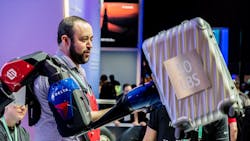Robotic exoskeletons from Sarcos Corp. enhance the power of infantry to carry heavy loads into action
SALT LAKE CITY – Forklifts and remote-controlled robots are great for brute force power. Popular Science reports. Continue reading original article
The Military & Aerospace Electronics take:
10 March 2020 -- They can easily lift 200-pound objects, but that strength typically comes at the cost of dexterity. Robotic specialist Sarcos Corp. in Salt Lake City, however, wants to put the humans inside the machines to handle the heavy lifting and the delicate details of industrial work all at once.
The robotic Sarcos Guardian XO has come a long way. “It was originally funded by the Defense Advanced Research Projects Agency in 2000,” says Sarcos chairman and CEO, Ben Wolff. “They wanted solutions to allow soldiers to carry more weight on their backs. Soldiers were carrying 100 pounds on their backs and walking for up to eight hours.”
The Guardian XO exoskeletons have switched from hydraulics to electric operation. Thanks to those changes, the XO now uses roughly 500 Watts per hour, even when it’s moving at full speed and carrying a heavy load. Operators can hot swap rechargeable batteries on the fly for constant operation, then charge the entire unit in its dock at the end of the day, like any gadget.
John Keller, chief editor
Military & Aerospace Electronics
